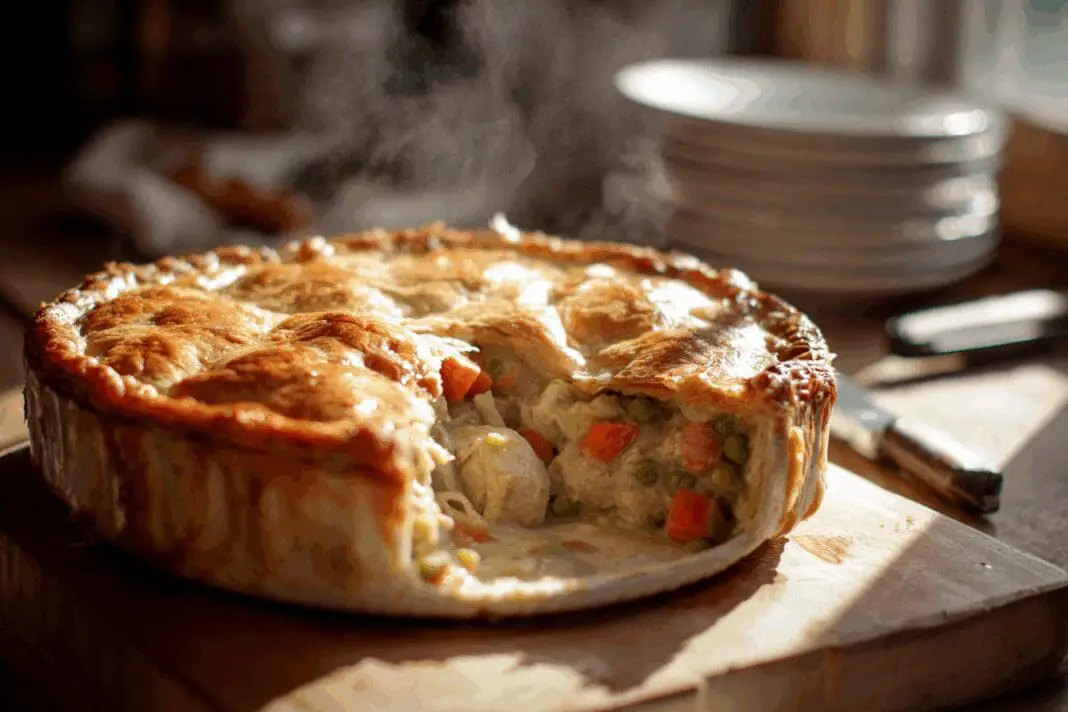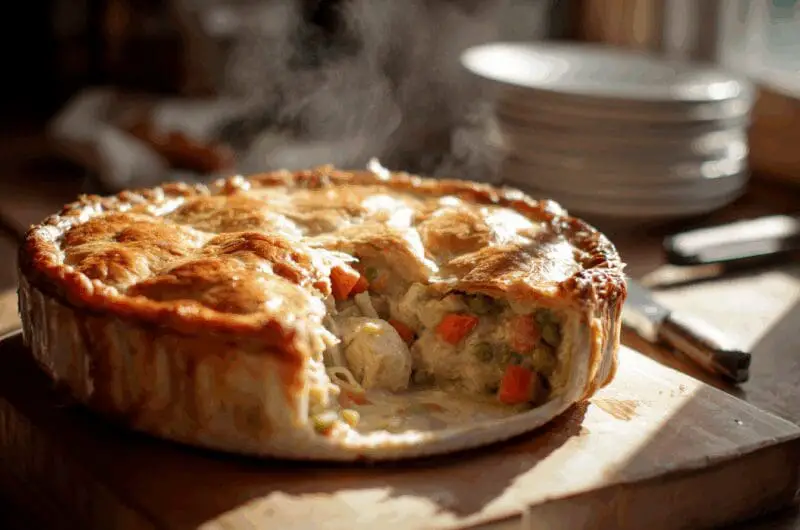Sunday dinners used to mean something special in American homes. Families gathered around tables loaded with dishes that took hours to prepare, and one of the most beloved was chicken pot pie. This hearty, comforting meal disappeared from many dinner tables as frozen versions took over, but nothing beats the rich, creamy filling and flaky homemade crust that made Sunday afternoons so memorable.
Why chicken pot pie ruled Sunday tables
Chicken pot pie became a Sunday staple because it perfectly captured what families wanted from their weekly feast. The dish transformed leftover roasted chicken into something extraordinary, stretching the meat with vegetables and a rich, creamy sauce. Grandmothers could start the preparation after church, letting the filling simmer while the family relaxed together.
The beauty of this dish lay in its ability to feed a crowd without breaking the bank. Traditional Sunday dinners required dishes that could satisfy everyone, and chicken pot pie delivered with its combination of protein, vegetables, and carbs all wrapped in buttery pastry. The cooking process was laborious but rewarding, making it perfect for leisurely Sunday afternoons when time moved slower.
What made the old-fashioned version special
The chicken pot pies grandmothers made bore little resemblance to today’s frozen versions. They started with real chicken, often from birds they’d roasted the day before, and vegetables that came from their own gardens or local markets. The filling was thick and creamy, made with real butter, cream, and a proper roux that took patience to perfect.
The crust made all the difference between store-bought and homemade versions. Made with lard or butter, these crusts were flaky, golden, and substantial enough to hold the generous filling without falling apart. Many classic dishes have been simplified over the years, but chicken pot pie lost much of its character when convenience took priority over taste and texture.
The rise and fall of convenience versions
Everything changed in the 1950s when C.A. Swanson introduced the first frozen chicken pot pie. Suddenly, families could have this Sunday dinner staple any night of the week without the hours of preparation. The convenience was undeniable, but something essential was lost in the translation from homemade to mass-produced.
Frozen pot pies became so popular that they completely overshadowed the original homemade versions. College students and busy families embraced the convenience, and gradually, the art of making chicken pot pie from scratch began to fade. The dish transformed from a special Sunday meal into a quick weeknight dinner, losing its status as comfort food worth waiting for.
Essential ingredients for authentic taste
Creating an authentic chicken pot pie starts with quality ingredients that mirror what grandmothers used decades ago. Fresh vegetables like carrots, celery, and peas provide color and texture, while onions add depth to the filling. The chicken should be tender and well-seasoned, preferably from a bird that’s been properly roasted or poached.
The sauce requires real butter, flour, and cream or whole milk to achieve the proper consistency and richness. Chicken stock, preferably homemade, adds another layer of flavor that store-bought versions simply can’t match. Fresh herbs like thyme and sage enhance the overall taste without overwhelming the other ingredients. Traditional recipes relied on simple, high-quality ingredients rather than shortcuts or artificial enhancements.
Mastering the perfect crust technique
The crust can make or break a chicken pot pie, and the old-fashioned method produces results that modern shortcuts can’t match. Cold butter or lard gets cut into flour until the mixture resembles coarse crumbs, then ice water brings everything together without overworking the dough. The key is keeping everything cold and handling the dough as little as possible.
Rolling the dough requires patience and a light touch. The bottom crust should be thick enough to support the filling without becoming soggy, while the top crust needs to be decorative and golden. Many grandmothers created beautiful patterns with leftover dough, turning their pot pies into edible works of art. Proper venting allows steam to escape, preventing the crust from becoming soggy while ensuring even cooking.
Building layers of rich, creamy filling
The filling separates exceptional pot pies from ordinary ones, and it starts with properly sautéed vegetables. Onions, carrots, and celery get cooked until tender but not mushy, creating a foundation of flavor. The chicken goes in next, already cooked and cut into bite-sized pieces that distribute evenly throughout the pie.
Creating the sauce requires attention and patience. A roux made from butter and flour needs time to cook properly, eliminating any raw flour taste while developing a golden color. Slowly adding warm chicken stock prevents lumps, while cream or milk provides richness. The consistency should coat the back of a spoon but still flow easily, as it will thicken further during baking.
Temperature control and baking secrets
Proper baking transforms raw ingredients into the golden, bubbling masterpiece that defined Sunday dinners. The oven temperature needs to be high enough to brown the crust but not so hot that it burns before the filling heats through. Most successful pot pies bake at 425°F for the first 15 minutes, then reduce to 350°F for the remainder.
Timing depends on several factors, including the temperature of the filling when it goes into the oven and the thickness of the crust. The pie is done when the crust is golden brown and the filling bubbles around the edges. A few minutes of resting time allows the filling to set slightly, making serving much easier and preventing a soupy mess on the plate.
Regional variations worth trying
Different regions developed their own takes on chicken pot pie, each reflecting local tastes and available ingredients. Pennsylvania Dutch versions often include square egg noodles in a brothier filling, creating more of a stew topped with pastry. Southern variations might include corn or green beans, while some New England recipes incorporate potatoes directly into the filling.
Some families preferred individual pot pies over large ones, allowing for portion control and eliminating arguments over who got the most crust. Others topped their pies with biscuit dough instead of pastry, creating a different texture that some found easier to manage. These variations show how adaptable the basic concept was, allowing families to make the dish their own while maintaining its essential comfort food appeal.
Common mistakes that ruin homemade pot pie
Even experienced cooks can stumble when making chicken pot pie from scratch, and most problems stem from rushing the process. Overworking the dough creates tough, chewy crust instead of flaky layers. Using filling that’s too hot can melt the bottom crust before it has a chance to set, resulting in a soggy mess that falls apart when served.
Underseasoning the filling is another common mistake that results in bland, disappointing pot pie. The filling should taste slightly overseasoned on its own, as the pastry will dilute the flavors. Skipping the egg wash on top means missing out on that beautiful golden color that makes homemade pot pie so appealing. Taking time with each step ensures results that honor the tradition of Sunday dinner pot pie.
Making chicken pot pie from scratch takes time and effort, but the results justify every minute spent in the kitchen. This dish represents everything wonderful about old-fashioned Sunday dinners: family gathering, patience rewarded with incredible food, and the satisfaction of creating something truly special with your own hands. Maybe it’s time to bring this classic back to Sunday tables where it belongs.
Classic Sunday Chicken Pot Pie
Course: DinnerCuisine: American8
servings45
minutes50
minutes425
kcalThis old-fashioned chicken pot pie brings back the rich, creamy comfort food that made Sunday dinners special for generations.
Ingredients
3 cups cooked chicken, diced
2 cups frozen mixed vegetables (carrots, peas, corn)
1 large onion, diced
3 celery stalks, diced
1/3 cup butter
1/3 cup all-purpose flour
2 cups chicken broth
1/2 cup heavy cream
2 refrigerated pie crusts
Directions
- Preheat your oven to 425°F and place the bottom pie crust in a 9-inch deep-dish pie pan. Press the crust gently into the pan and trim any excess, leaving about 1 inch overhang. Set aside while you prepare the filling.
- In a large skillet, melt the butter over medium heat. Add the diced onion and celery, cooking for 5-6 minutes until softened. The vegetables should be tender but not browned, as they’ll continue cooking in the oven.
- Sprinkle the flour over the cooked vegetables and stir constantly for 2 minutes to create a roux. This step eliminates the raw flour taste and helps thicken the filling. The mixture should be golden and fragrant.
- Gradually add the chicken broth, whisking constantly to prevent lumps from forming. Bring the mixture to a simmer and cook for 2-3 minutes until thickened. The sauce should coat the back of a spoon but still flow easily.
- Stir in the heavy cream, diced chicken, and frozen vegetables. Season with salt, pepper, and dried thyme to taste. Remove from heat and let the filling cool for 10 minutes before assembling the pie.
- Pour the cooled filling into the prepared pie crust, spreading it evenly. Place the top crust over the filling and crimp the edges to seal. Use a sharp knife to cut 4-5 small vents in the top crust to allow steam to escape.
- Brush the top crust with beaten egg for a golden finish. Place the pie on a baking sheet to catch any drips and bake at 425°F for 15 minutes. Reduce temperature to 350°F and continue baking for 30-35 minutes.
- The pot pie is done when the crust is golden brown and the filling bubbles around the edges. Let it rest for 10 minutes before serving to allow the filling to set slightly. Serve hot with a simple green salad.
Notes
- For best results, use rotisserie chicken or leftover roasted chicken for maximum flavor
- If the crust edges brown too quickly, cover them with foil strips during baking
- Leftover pot pie can be refrigerated for up to 3 days and reheated in a 350°F oven
Frequently asked questions
Q: Can I make the pot pie ahead of time?
A: Yes, you can assemble the entire pot pie up to 24 hours in advance and refrigerate it before baking. Just add 10-15 extra minutes to the baking time if cooking from cold.
Q: What’s the best way to prevent a soggy bottom crust?
A: Make sure your filling has cooled before adding it to the crust, and consider blind-baking the bottom crust for 10 minutes before adding the filling for extra insurance against sogginess.
Q: Can I freeze chicken pot pie?
A: Absolutely! Freeze the unbaked pie for up to 3 months. Bake directly from frozen, adding 20-30 minutes to the total cooking time and covering with foil if the crust browns too quickly.
Q: What vegetables work best in chicken pot pie?
A: Traditional choices include carrots, peas, celery, and onions, but you can add corn, green beans, or mushrooms. Avoid vegetables with high water content like tomatoes or zucchini as they can make the filling watery.


